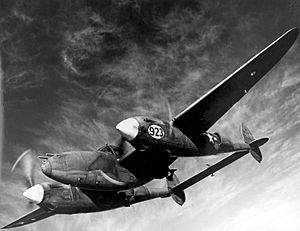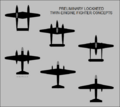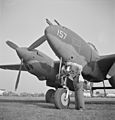Lockheed P-38 Lightning facts for kids
Quick facts for kids |
|
|---|---|
 |
|
| P-38H of the AAF Tactical Center, Orlando Army Air Base, Florida, carrying two 1,000 lb bombs during capability tests in March 1944 | |
| Role | Heavy fighter |
| National origin | United States |
| Manufacturer | Lockheed Corporation |
| Designer | Clarence "Kelly" Johnson |
| First flight | 27 January 1939 |
| Introduction | July 1941 |
| Retired | 1949 (United States Air Force) 1965 (Honduran Air Force) |
| Primary users | United States Army Air Forces Free French Air Force |
| Produced | 1941–45 |
| Number built | 10,037 |
| Unit cost | US$97,147 in 1944 |
| Developed into | Lockheed XP-49 Lockheed XP-58 |
The P-38 Lightning was a very special World War II fighter plane. It was made by the Lockheed company. This aircraft was mainly used by the United States Army Air Forces. It first flew in 1939, before the war officially began for the U.S.
What made the P-38 different was its unique design. Unlike most fighter planes that had one engine, the P-38 had two! It also had a twin-boom tail, which looked like two separate tails joined together. This gave it a very distinct shape. The Germans even nicknamed it the "fork-tailed devil" because of its unusual look and how dangerous it was.
The P-38 Lightning was one of the fastest planes of its time. It could fly at over 400 miles per hour. It carried powerful weapons, including four .50-caliber machine guns and a 20mm cannon. This made it a strong opponent in air battles.
This amazing aircraft fought in both the Pacific and European parts of World War II. It was not just a fighter; it also took many important aerial photos. In fact, it captured about 90% of all air footage over Europe during the war. The P-38 was the only American fighter plane that was being built at both the start and the end of the war.
Contents
Design and Features
The P-38 Lightning had a very unusual design for a fighter plane. Most fighters had a single body with one engine. But the P-38 had a central pod for the pilot and weapons. On either side of this pod, there were two long "booms" that held the engines and ended in tail sections.
Twin Engines and Speed
Having two engines made the P-38 very powerful. It could fly faster and higher than many other planes. If one engine was damaged, the pilot could sometimes still fly the plane with the other engine. This was a big advantage in combat.
The P-38 was one of the fastest planes in the world when it was first introduced. Its speed helped it to catch enemy planes and escape danger. It was also very good at climbing quickly to high altitudes.
Powerful Weapons
The P-38 carried its weapons in the nose of the central pod. This included four .50-caliber machine guns and a 20mm cannon. Having all the weapons in the nose meant that the bullets and shells flew in a straight line. This made it easier for pilots to hit their targets.
This concentrated firepower was very effective against enemy aircraft and ground targets. The P-38 could deliver a lot of damage in a short amount of time.
Pilot Controls
Unlike many other fighter planes that used a stick, the P-38 was flown with a yoke, similar to what you might find in a larger transport plane. This was another unique feature of the Lightning.
Role in World War II
The P-38 Lightning played many important roles during World War II. It was used for fighting enemy planes, attacking targets on the ground, and taking reconnaissance photos.
Fighting in the Pacific
In the Pacific Ocean, the P-38 was especially important. Its long range meant it could fly long distances over the ocean. This was crucial for battles against Japan. It was also very good at fighting at high altitudes, which was common in the Pacific theater.
Many famous American "ace" pilots, who shot down many enemy planes, flew the P-38 in the Pacific. One of the most famous was Major Richard Bong, who became America's top ace with 40 victories.
Missions in Europe
While the P-38 was very successful in the Pacific, it faced different challenges in Europe. The weather conditions were often colder, and German fighter planes were very skilled. By 1944, the P-38 was often replaced by the P-51 Mustang in Europe, which was even faster and had a longer range.
However, the P-38 still performed vital missions. It was used for bombing, ground attacks, and especially for photo reconnaissance. Its ability to fly high and fast made it perfect for taking pictures of enemy positions.
Reconnaissance Missions
The P-38 was excellent at taking aerial photographs. Special versions of the plane, called F-4 and F-5 Lightnings, were made just for this purpose. They had cameras instead of guns in their noses. These planes flew over enemy territory, taking pictures that helped military leaders plan their strategies.
The famous French writer and pilot Antoine de Saint-Exupéry flew a P-38 for reconnaissance missions during the war. His plane disappeared during one of these flights in 1944. Parts of his plane were found many years later in the Mediterranean Sea.
Legacy of the Lightning
Over 10,000 P-38 Lightnings were built during World War II. It was a very important aircraft for the United States. Even after the war, some countries, like the Honduras Air Force, continued to use the P-38 for many years.
The P-38 Lightning remains a symbol of American air power and innovation during World War II. Its unique design and impressive performance make it one of the most recognizable planes from that era.
Images for kids
-
Mechanized P-38 assembly lines in Burbank, California: Planes start at the back of the building on the far right (without wings, so that section of the line is narrower). When they reach the end of that line, they shift to the center line, gain wings, and move backward down this line. Upon reaching the end, they are then shifted to the line at the left, and progress forward to the end of the line.
-
Reconnaissance P-38 with bold black and white invasion stripes participating in the Normandy Campaign
-
P-38s of the 370th Fighter Group at RAF Andover in southern England
-
Ground crew members of the 459th Fighter Squadron, nicknamed the "Twin Dragon Squadron", working on a Lockheed P-38 at an air base in Chittagong, India – January 1945
-
(L–R) Thomas B. McGuire and Charles Lindbergh discussing a mission on Biak Island in July 1944
-
Lockheed P-38L Lightning at the National Museum of the United States Air Force, marked as a P-38J of the 55th Fighter Squadron, based in England
See also
 In Spanish: Lockheed P-38 Lightning para niños
In Spanish: Lockheed P-38 Lightning para niños






























